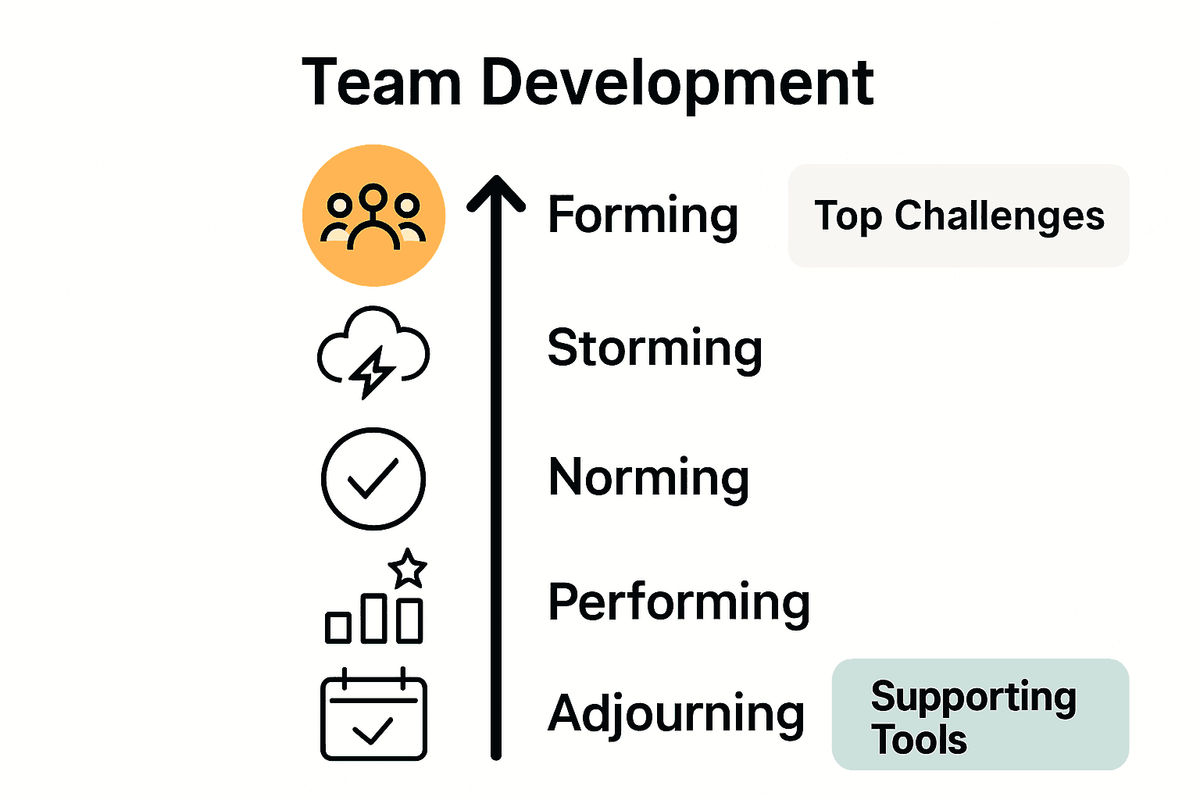Team Development Explained: Stages, Tools, and Best Practices
October 31, 2025

Did you know that teams with clear roles outperform others by up to 50 percent according to recent studies? When individuals come together, success depends on much more than talent alone. Group dynamics, defined responsibilities, and strategic collaboration drive real results. Understanding how teams evolve, the roles that matter most, and proven team-building strategies gives every organization the chance to reach their highest potential.
Table of Contents
- Defining Team Development and Core Concepts
- Stages of Team Development Process
- Essential Roles and Responsibilities in Teams
- Effective Tools and Techniques for Team Building
- Common Pitfalls and How to Avoid Them
Key Takeaways
| Point | Details |
|---|---|
| Team Development Stages | Teams progress through five stages: Forming, Storming, Norming, Performing, and Adjourning, each presenting unique challenges and growth opportunities. |
| Strategic Roles Allocation | Effectively assigning roles like Team Leader, Coordinator, and Subject Matter Expert enhances collaboration and accountability within the team. |
| Proactive Problem-Solving | Anticipating common pitfalls such as poor communication and undefined roles allows teams to transform potential issues into avenues for growth. |
| Structured Team-Building Techniques | Utilizing methods like regular feedback sessions and collaborative decision-making strengthens team dynamics and facilitates better performance. |
Defining Team Development and Core Concepts
Team development is the transformative journey through which a group of individuals becomes a unified, high-performing collective. According to hr.mit.edu, this process involves how team members learn to collaborate, establish shared norms, and work towards common organizational objectives. It's not just about assembling talented individuals, but creating a synergistic environment where collective potential can be realized.
The core concept of team development centers on progressive stages that systematically enhance group effectiveness. socialsci.libretexts.org highlights five critical stages that teams typically progress through:
- Forming: Initial connection and orientation
- Storming: Establishing interpersonal dynamics and challenging initial assumptions
- Norming: Developing group cohesion and shared expectations
- Performing: Achieving peak collaborative efficiency
- Adjourning: Concluding team project and reflecting on collective achievements
Understanding these stages helps leaders and team members navigate group dynamics more intentionally. By recognizing each phase's unique challenges and opportunities, organizations can create more resilient, adaptive teams that consistently deliver exceptional results. Understanding Effective Ways to Promote Teamwork provides additional insights into fostering collaborative environments that support continuous team development.
Stages of Team Development Process
Team development follows a dynamic progression that transforms a group of individuals into a cohesive, high-performing unit. hr.mit.edu highlights Bruce Tuckman's renowned model, which outlines five critical stages that teams universally experience: Forming, Storming, Norming, Performing, and Adjourning. These stages represent a predictable yet fluid journey of group evolution.
According to ncs.uchicago.edu, the team development process is not linear but a complex interaction of interpersonal dynamics. Each stage presents unique challenges and opportunities for growth:
Here's a summary of the five stages of team development and their key characteristics:

| Stage | Main Focus | Typical Challenges |
|---|---|---|
| Forming | Orientation Initial group bonding | Uncertainty Lack of clarity |
| Storming | Role clarification Conflict management | Disagreements Power struggles |
| Norming | Cohesion Establishing norms | Resistance to change Reluctance |
| Performing | Peak collaboration Efficient teamwork | Maintaining momentum |
| Adjourning | Project closure Reflection | Separation anxiety Transitions |
- Forming Stage: Initial introductions, tentative interactions, and establishing basic group structures
- Storming Stage: Challenging initial assumptions, navigating conflicts, and defining roles
- Norming Stage: Developing shared expectations, building trust, and establishing collaborative mechanisms
- Performing Stage: Achieving peak efficiency, seamless collaboration, and delivering exceptional results
- Adjourning Stage: Reflecting on collective achievements, transitioning, and potential team dissolution
Successful team development requires intentional leadership and understanding of these intricate stages. By recognizing the nuanced transitions between phases, managers can provide targeted support, facilitate smoother interactions, and create an environment that nurtures collective potential.
Complete Guide to Successful Team-Building Tips offers additional strategies for navigating these critical team development stages effectively.
Essential Roles and Responsibilities in Teams
Building a high-performing team requires careful allocation of strategic roles and responsibilities. According to hr.mit.edu, effective teams establish clear accountability by deliberately assigning specific roles that ensure smooth collaboration and goal achievement. These roles go beyond traditional hierarchical structures, focusing instead on functional contributions that drive collective success.
socialsci.libretexts.org highlights several critical team roles that contribute to group effectiveness:
- Team Leader: Sets overall direction, facilitates decision-making
- Coordinator: Manages task allocation and tracks project progress
- Recorder: Documents discussions, decisions, and action items
- Timekeeper: Ensures meetings stay on schedule and tasks are completed timely
- Subject Matter Expert: Provides specialized knowledge and technical insights
Successful team dynamics emerge when members understand and embrace their specific responsibilities while remaining flexible enough to support collective goals. How to Manage Team Dynamics for Optimal Collaboration provides additional strategies for creating a collaborative environment where individual strengths complement team objectives. By thoughtfully distributing roles and fostering mutual accountability, teams can transform individual talents into remarkable collective achievements.

Effective Tools and Techniques for Team Building
Team building requires strategic approaches that transform individual talents into collective strengths. hr.mit.edu emphasizes the importance of structured processes like setting clear goals, establishing ground rules, and designing purposeful team-building activities that enhance cohesion and performance.
socialsci.libretexts.org highlights several critical techniques for strengthening team dynamics:
- Regular Feedback Sessions: Creating opportunities for open communication
- Collaborative Decision-Making: Involving team members in strategic choices
- Conflict Resolution Workshops: Teaching constructive problem-solving skills
- Team Assessment Tools: Using personality and skills inventories
- Interactive Team Challenges: Developing trust through shared experiences
These techniques work best when tailored to a team's unique composition and organizational culture. Understanding Team Building Tips 2025 for Effective Teams provides additional context for implementing modern team development strategies. By combining structured approaches with genuine interpersonal connection, organizations can create resilient, high-performing teams that adapt and excel in dynamic environments.
Common Pitfalls and How to Avoid Them
Team development is fraught with potential challenges that can derail collective progress. hr.mit.edu identifies critical pitfalls that frequently undermine team effectiveness, including lack of clear goals, poor communication, and unresolved conflicts. These obstacles can transform promising teams into dysfunctional groups if not proactively addressed.
socialsci.libretexts.org highlights additional challenges teams must navigate:
- Member Dominance: Preventing individual team members from overshadowing collective input
- Lack of Engagement: Addressing passive participation and disinterest
- Communication Breakdowns: Establishing clear communication channels
- Undefined Roles: Clarifying individual responsibilities and expectations
- Conflict Avoidance: Creating safe spaces for constructive disagreement
Successful teams transform potential pitfalls into opportunities for growth and learning. 10 Engaging Big Group Team Building Games for Success offers innovative strategies for building team resilience and maintaining productive group dynamics. By anticipating challenges and implementing proactive solutions, organizations can create adaptive, high-performing teams that turn obstacles into stepping stones for collective achievement.
Elevate Your Team Development with Engaging Interactive Experiences
Navigating the stages of team development like forming, storming, and performing can be challenging without the right tools to inspire collaboration and communication. This article highlights critical pain points such as managing team dynamics and fostering cohesion through effective roles and structured activities. Bringing energy into your team-building process plays a vital role in transforming groups into high-performing units.

Discover how quizado.com offers customizable, interactive quiz games designed to boost teamwork while keeping engagement high. Our platform supports remote and in-person play and allows personalization with your own branding to strengthen team identity. It is a perfect solution to reinforce team development concepts like regular feedback, conflict resolution, and shared goals with fun, dynamic activities. Start creating memorable team-building moments today by visiting quizado.com and explore how to manage team dynamics along with successful team-building tips that complement your development strategy perfectly.
Frequently Asked Questions
What are the stages of team development?
Team development typically follows five stages: Forming (orientation and initial bonding), Storming (establishing roles and navigating conflicts), Norming (developing cohesion and shared expectations), Performing (achieving peak collaboration), and Adjourning (closure and reflection).
How can leaders support team development?
Leaders can enhance team development by understanding the unique challenges of each stage, providing targeted support, facilitating open communication, and encouraging collaboration among team members.
What are some effective tools for team building?
Effective tools for team building include regular feedback sessions, collaborative decision-making processes, conflict resolution workshops, team assessment tools, and interactive team challenges designed to build trust and cohesion.
What are common pitfalls in team development and how can they be avoided?
Common pitfalls in team development include lack of clear goals, poor communication, unresolved conflicts, and undefined roles. These can be avoided by setting explicit objectives, establishing open communication channels, and clarifying responsibilities within the team.



